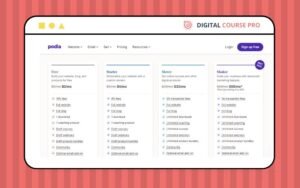How to sell a course online through a landing page is a question many aspiring course creators ask as they navigate the world of online education. A well-crafted landing page is crucial for converting visitors into paying students. It acts as a central hub where potential students can learn about your course, understand its benefits, and take the leap to enroll. In this post, we’ll guide you through the essential steps to create an effective landing page and how to use email marketing tools like MailerLite and ConvertKit to boost your sales.

Why a Landing Page is Essential
How to Sell a Course Online Through a Landing Page is all about creating compelling content, understanding your audience, and optimizing for conversions to successfully attract and enroll students in your online course. A landing page is a standalone web page created specifically for marketing or advertising a product. It’s designed to convert visitors into leads or customers by providing them with the information they need to make a purchase decision. For online courses, a landing page serves as the focal point where potential students can learn about the course, see its benefits, and sign up.
How to Sell a Course Online Through a Landing Page: Steps to Creating an Effective Landing Page
Selling a course online through a landing page requires a strategic approach to ensure it effectively engages visitors and converts them into students. The first step is to define your target audience and understand their needs and preferences. This insight will guide the design and messaging of your landing page. Crafting a compelling headline is crucial—it should instantly grab attention and convey the main benefit of your course. Follow this with persuasive copy that outlines what the course offers, emphasizing the value and transformation students can expect.
In addition to text, include high-quality visuals such as images, videos, or infographics that showcase your expertise and the content of your course. Social proof plays a vital role in building trust, so incorporate testimonials, reviews, or success stories from past students to demonstrate the credibility and effectiveness of your course. A clear call-to-action (CTA) is essential—make it prominent and compelling, guiding visitors to take the next step, whether it’s enrolling in the course, signing up for a free trial, or subscribing to your email list for more information.
Optimize your landing page for mobile devices to ensure a seamless user experience across all screen sizes. Test the page to ensure fast loading times and easy navigation. Once your landing page is live, monitor its performance using analytics tools to track metrics such as conversion rates and visitor behavior. Continuously test and tweak elements of the landing page—including headlines, visuals, CTAs, and placement of social proof—to optimize conversion rates over time.
How to Sell a Course Online Through a Landing Page involves understanding your target audience, crafting persuasive content, and optimizing for conversions to effectively drive course sales and grow your online education business.
1. Define Your Target Audience
Before creating your landing page, it’s essential to understand who your target audience is. This will help you tailor your message and design to meet their needs and preferences. Consider factors like age, gender, interests, and pain points that your course can address.
2. Craft a Compelling Headline
Your headline is the first thing visitors will see, so it needs to grab their attention immediately. It should be clear, concise, and highlight the main benefit of your course. For example, “Master Photography in 30 Days: A Comprehensive Online Course.”
3. Write Persuasive Copy
The body of your landing page should provide detailed information about your course. Highlight the key benefits, what students will learn, and any unique features that set your course apart. Use bullet points, subheadings, and short paragraphs to make the content easy to read.
4. Include Social Proof
Testimonials, reviews, and case studies from past students can significantly boost your credibility. Include quotes, star ratings, and even video testimonials if possible. This social proof can reassure potential students of the value of your course.
5. Use High-Quality Visuals
How to Sell a Course Online Through a Landing Page requires strategic design and persuasive content to attract potential students and convert them into enrolled learners effectively. Images and videos can make your landing page more engaging and visually appealing. Include photos of yourself (the instructor), screenshots from the course, and any other relevant visuals that can help illustrate the course content and benefits.
6. Create a Clear Call-to-Action (CTA)
Your CTA should be prominently displayed and encourage visitors to take the next step, whether it’s signing up for a free trial, purchasing the course, or subscribing to your email list. Use action-oriented language like “Enroll Now,” “Get Started,” or “Join Today.”
7. Optimize for Mobile
Many users will access your landing page from mobile devices, so ensure it is fully responsive and looks great on all screen sizes. Test your landing page on different devices to ensure a seamless user experience.
Leveraging Email Marketing with MailerLite and ConvertKit
Email marketing is a powerful tool for nurturing leads and converting them into paying students. Tools like MailerLite and ConvertKit offer features that make this process easier and more effective.
Using MailerLite
1. Build Your Email List:
Start by creating an email sign-up form on your landing page. Offer a freebie, such as a mini-course, ebook, or cheat sheet, to entice visitors to join your list.
2. Segment Your Audience:
Segment your email list based on different criteria, such as interests, engagement level, or where they are in the buyer’s journey. This allows you to send more targeted and relevant emails.
3. Create an Email Sequence:
Set up an automated email sequence to nurture your leads. This could include a welcome email, a series of educational emails about the course topic, and a final sales pitch. MailerLite’s automation features make it easy to set this up.
4. Track and Optimize:
Monitor the performance of your email campaigns through MailerLite’s analytics dashboard. Track open rates, click-through rates, and conversions to see what’s working and what needs improvement.
Using ConvertKit
1. Create Landing Pages:
ConvertKit offers customizable landing page templates, making it easy to create professional-looking pages without needing a separate website. Use these templates to build a landing page specifically for your course.
2. Tag and Segment Subscribers:
ConvertKit’s tagging system allows you to segment your subscribers based on their behavior and interests. For example, tag users who have shown interest in your course but haven’t enrolled yet.
3. Develop an Email Funnel:
Set up an email funnel that guides potential students from awareness to purchase. Start with educational content that provides value and builds trust, followed by more focused emails that address objections and highlight the course’s benefits.
4. Use Advanced Automations:
ConvertKit’s advanced automation features let you create complex workflows based on subscriber actions. For example, if a subscriber clicks a link to learn more about your course, you can trigger a series of follow-up emails designed to convert them into a student.
Combining Landing Pages and Email Marketing
Combining landing pages and email marketing is a powerful strategy to maximize conversions and drive sales for your online course. A well-designed landing page acts as the entry point for potential students, providing them with compelling information about your course and encouraging them to take action. It should feature a captivating headline, persuasive copy that highlights the benefits of your course, social proof such as testimonials or reviews, and a clear call-to-action (CTA) that prompts visitors to enroll.
Once visitors land on your page and express interest by signing up or clicking on your CTA, email marketing steps in to nurture these leads further. Tools like MailerLite and ConvertKit allow you to automate this process with email sequences tailored to different stages of the customer journey. For instance, you can set up automated welcome emails for new subscribers, followed by educational content that builds trust and credibility. As potential students progress through your email funnel, you can strategically introduce offers, testimonials, and additional information to persuade them to purchase your course.
Moreover, segmenting your email list based on interests, engagement levels, or demographics enables you to send targeted messages that resonate with specific groups of subscribers. This personalized approach increases the likelihood of conversion by delivering relevant content and addressing the unique needs of each segment. Additionally, tracking email performance metrics such as open rates, click-through rates, and conversion rates provides valuable insights into what strategies are working best and where adjustments may be needed.
By seamlessly integrating landing pages with email marketing, you create a cohesive user experience that guides potential students from initial interest to enrollment. This not only boosts conversion rates but also fosters long-term relationships with your audience, leading to repeat enrollments and positive word-of-mouth referrals. As you refine your landing pages and email campaigns over time based on analytics and feedback, you can continuously optimize your strategy to achieve even greater success in selling your online course.
To maximize your sales, your landing page and email marketing efforts should work together seamlessly. Here’s how to integrate them effectively:
- Promote Your Landing Page:
Use email marketing to drive traffic to your landing page. Send an initial email to your list announcing the course and providing a link to the landing page. - Follow Up with Interested Leads:
Use email automation to follow up with visitors who have shown interest in your course but haven’t enrolled yet. Send reminders, offer limited-time discounts, and provide additional information to encourage them to sign up. - Provide Ongoing Value:
Even after someone has enrolled in your course, continue to engage them with valuable content. This can lead to repeat purchases and referrals. Use email marketing to send updates, new course announcements, and exclusive offers.
Conclusion
Selling an online course through a landing page involves strategic planning and execution, where both design and content play crucial roles. To maximize your conversions, it’s essential to integrate an effective email marketing strategy. Tools like MailerLite and ConvertKit can significantly enhance your efforts by automating your email campaigns, segmenting your audience, and tracking your results. If you’re trying to decide which tool to use, I highly recommend reading our comprehensive comparison, “MailerLite vs ConvertKit 2024 – Which is the Best Email Marketing Tool?” This article will help you understand the strengths and weaknesses of each platform, ensuring you choose the best one for your needs.
Remember, the key to success lies in understanding your audience, providing valuable content, and maintaining consistent communication. With these strategies in place, you’ll be well on your way to creating a profitable online course business.
For more tips on creating and selling online courses, check out our post, “Explore Teachable Free Trial: 7 Key Benefits,” to learn how Teachable can help you launch your course with ease.





